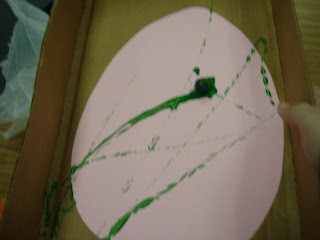During circle time, we talked a lot about butterflies. We looked at our bulletin board to review the vocabulary. We also used the fun and simple song "Look at the Butterflies" from Deborah Stewart's blog Little Fingers That Play. I printed up the pages from the visuals on the website and I did my best to sing the song. It's a great song to talk about the vocabulary (butterfly) and to sneak in some counting to 5!
Then, in small group rotations, we painted some beautiful butterflies!
Targets
Vocabulary-butterfly
Concepts- half/whole; same
Colors
First, we gathered our materials--
A variety of paints (we eventually put into cups), paintbrushes, butterfly patterns that were pre-cut and folded in half
Now, when I made the sample butterfly, I added the paint by squeezing straight from the bottle.
There were a few problems with that, so we brainstormed a bit and decided it would work just as well to have the students use paint brushes!
We started with the students requesting their butterfly (I want a butterfly). We talked about how they were folded in half and opened them up to show they whole butterfly. We talked about how they were only going to paint on one half. We even covered up the other half to give them help.
Then, they got to painting. They requested the paint (I want red; I want blue, etc). They could paint any way they wanted, but we did try to encourage that they copy some forms, like circles and lines and eyes.
Then, they folded the butterfly in half again and spread the paint around.
We found that they had to do this quickly because the paint dried pretty quickly and stuck the butterfly together!
We opened up the butterfly again to show the whole butterfly. We talked about how cool and magical it was that both halves looked the same!
Our butterflies came out very beautifully and we had them fly onto our windows to be displayed!
I love getting feedback, so please leave a comment!
.



























































